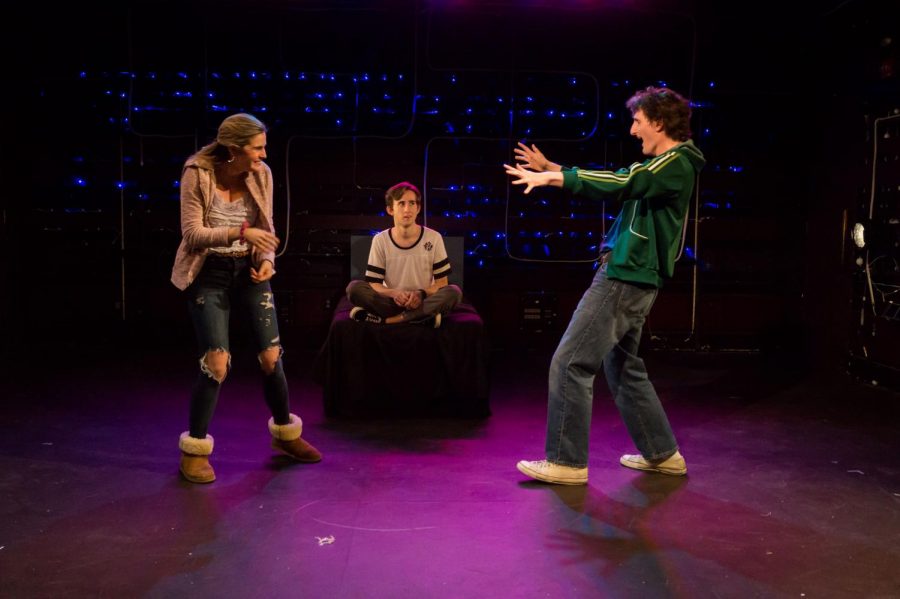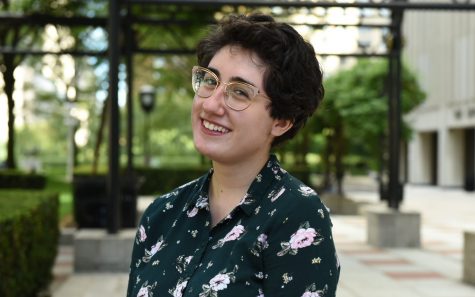Fordham at the Fringe
PHOTO COURTESY OF KYRA CONROY
“Dark Play” was first performed in Fordham’s studio theater in the spring.
September 17, 2019
An everyday visitor to Scotland’s capital will encounter a bustling yet idyllic city of cobblestone streets, old clock towers and a castle whose towering presence could put a New York skyscraper to shame.
But for the month of August, many of Edinburgh’s tourists flocked to a much different scene. Juxtaposed against the rest of Edinburgh’s apparent placidity was the Royal Mile, the heart of the Edinburgh Fringe Festival, which pulsed with near-tangible energy and a ceaseless flurry of activity.
Thousands of thespians occupied hundreds of venues with all their shows’ trappings in tow. Actors, producers and spectators alike doubled as barkers, eagerly promoting their shows with flyers and merchandise.
Among them all, as the sun rose on Monday, Aug. 19, one group of Fordham College at Lincoln Center (FCLC) students rushed around theSpace (yes, stylized ironically with no space in its name) with neon tubing and only 10 minutes to put it up before “Dark Play or Stories for Boys” opened to the world.
Just because the show was named one of the 10 must-see LGBT shows of the year’s festival by the Edinburgh Fringe before its run even started didn’t mean the world just appeared in the seats. The cast and crew had some barking of their own in store.
“Flyering is no joke!” said producer Elizabeth Kline, FCLC ’19. “You can barely walk 5 steps without someone trying to give you a flyer. I found it difficult at first, but once I found my one sentence plug, I got into a rhythm. We were the only show with wristbands and bottle openers, so that set us apart because people were literally wearing our show information.”
Some might remember “Dark Play” (sans bottle openers) from its performances in the Veronica Lally Kehoe Studio Theatre this past February. The play, by Carlos Murillo Zamora, follows a boy named Nick — Clayton Barth, FCLC ’22 — and his experimentation with “dark play,” the phenomenon where some people in a game don’t know they’re in a game. Nick’s “dark play” takes the form of a fake female persona — McKenna Harrington, FCLC ’20 — with whom he catfishes another boy — Parker Henderson, FCLC ’21 — online. The endeavor gets unexpectedly complicated when Nick becomes obsessed with the game and its unwitting victim.
It’s a story for the digital age, but not necessarily in its current incarnation. The chat-room setting evokes the bygone days of AOL Instant Messenger, which the target audience of teens and college students may rather forget, considering that they likely used that platform in middle school.
Lighting designer Vittoria Orlando, FCLC ’21, was surprised to find that “Dark Play” attracted an entirely different demographic this time around.
“The people who wound up seeing our show were people ranging from mid-40s to — some people even seemed to be in their early 70s,” Orlando said. “That wasn’t the audience we had had here [at Fordham], but they were really listening. There wasn’t as much laughter and taking things as lightly as a younger audience did, but they were definitely more focused on what was happening.”
All in all, about 120 people saw the show in its 3-day Edinburgh run. That meant 40 people filled the seats each morning in a 50-person theater — certainly more than any of the students ever bargained for. Like Harrington’s character Rachel, the idea of taking the story to the Fringe seemed at first an unreachable fantasy. “Dark Play” for months was but a ghost of a Kehoe show past. It was a ghost that haunted the group with a nagging sadness over its end.
“Usually after studio shows, amidst the sense of pride and accomplishment there is at least a little bit of relief to have closed,” said director Marc David Wright, FCLC ’19. “But none of us were happy.”
And then came the idea: perhaps it could be resurrected.
“At our cast party, Marc was just like, ‘What if we took this to the Fringe?’” sound designer Amelia Way, FCLC ’21, recalled. “It started as a joke, sort of like an aspiration that we thought would never really happen, and then it became more real as we just kept talking about it.” The tipping point was a matter of funds; the production received Fordham’s Ars Nova grant and met their $5,000 goal on GoFundMe. The green was rolling in — and the rolling green hills of Scotland began manifesting on the horizon. Before the group knew it, Kline had booked the flights and the theater, and they were on a plane.
All the cast and crew from the studio production reprised their same roles in Edinburgh (with the exception of Kline, who joined in May). The show itself, though, had to undergo a rehaul before hitting the Fringe. The festival’s hard one-hour-per-show time limit required the team to make significant cuts to the 90-minute play — and according to Wright, the redesign and restaging had to come together in only one week of New York rehearsals.
“Our new theatre space was structured completely differently than the Kehoe at Fordham, and how we had staged and designed the last production was very dependent on the architecture of Kehoe,” said Wright. “We had to rethink everything. And I think we found something stronger than the original.
“We had to waste no time, so everything required focus and diligence,” he added. “I felt like I was running on pure adrenaline. It brought out the best and the strongest in everyone.”
It ultimately brought out positivity in audiences too. One reviewer called it “the best show [he’d] seen and reviewed at the Fringe” — and there were more accolades where that came from. Everyone had their own encounter: Orlando remembered a man who asked the cast to take a photo with him and sign his sweatshirt. Bailey Jordan Garcia, who played Nick’s mom, talked to a man “who was so happy to see young, queer stories onstage.” One girl stopped Kline and Wright in the street to show them a picture on her Snapchat story whose caption said she planned to see “Dark Play” again because it was her favorite show.
Some of the most meaningful support, though, came from fellow Edinburgh performers. Multiple students in “Dark Play” mentioned that after attending other shows, the actors from those shows would come to “Dark Play.” The occurrence was common, and it created a strong sense of camaraderie that extended beyond the students. The mere presence of a non-Fordham audience was enough to have an emotional impact on the group, especially Wright.
“During our opening performance at the festival I looked out into the audience and realized I did not recognize a single face,” he said. “It was an audience of complete strangers who had either been handed a flyer by our team on the street or read an article about us online and decided to take a chance on us. That is why we wanted to do this — to take our work and see how it stands in the ‘real world.’
“My whole life in theatre, I’ve been performing mostly for family, friends, people I would recognize in the audience … To share work with a completely new audience, who had no idea who we were and had no expectations for what we were capable of, and then to have them cheer us on as well… that was very moving.”
The cast and crew grew closer, even solidifying their team with an official moniker: The Neon Box Theatre Company, named for the neon tubing used in their set. “Dark Play” took up a relatively small amount of their time, so they spent the rest seeing other shows — as many as four and five per day. One night, they escaped the frenzy of the Mile and hiked up to Arthur’s Seat, the city’s highest peak, where they took in Scotland’s tranquil landscape and a brilliant sunset together.
“We’re a huge family,” Way said. “This trip could have either made us all hate each other or love each other even more, and we just love each other even more.”
Wright said, “Who would’ve thought that a little studio show in Kehoe could’ve taken us here?”













